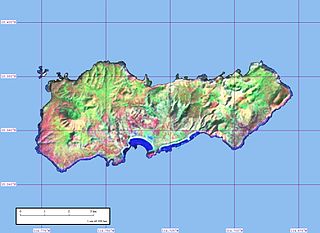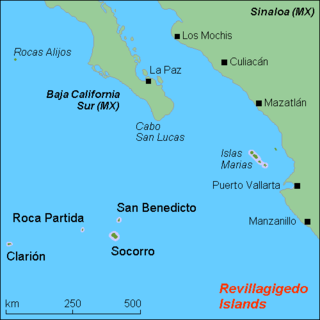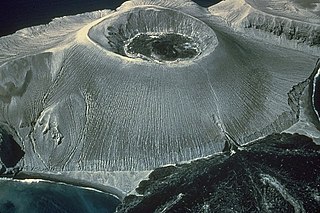
Shearwaters are medium-sized long-winged seabirds in the petrel family Procellariidae. They have a global marine distribution, but are most common in temperate and cold waters, and are pelagic outside the breeding season.

The Revillagigedo Islands or Revillagigedo Archipelago are a group of four volcanic islands in the Pacific Ocean, known for their unique ecosystem. They lie approximately 458 kilometres (285 mi) from Socorro Island south and southwest of Cabo San Lucas, the southern tip of the Baja California Peninsula, and 698 to 1,092 kilometres west of Manzanillo. Historically linked to the Mexican state of Colima, to which they were granted in 1861 to establish a penal colony, the islands are under Mexican federal property and jurisdiction.

The blue-footed booby is a marine bird native to subtropical and tropical regions of the eastern Pacific Ocean. It is one of six species of the genus Sula – known as boobies. It is easily recognizable by its distinctive bright blue feet, which is a sexually selected trait and a product of their diet. Males display their feet in an elaborate mating ritual by lifting them up and down while strutting before the female. The female is slightly larger than the male and can measure up to 90 cm (35 in) long with a wingspan up to 1.5 m (5 ft).

Socorro Island is a volcanic island in the Revillagigedo Islands, a Mexican possession lying 600 kilometres (370 mi) off the country's western coast. The size is 16.5 by 11.5 km, with an area of 132 km2 (51 sq mi). It is the largest of the four islands of the Revillagigedo Archipelago. The last eruption was in 1993.

The wedge-tailed shearwater is a medium-large shearwater in the seabird family Procellariidae. It is one of the shearwater species that is sometimes referred to as a muttonbird, like the sooty shearwater of New Zealand and the short-tailed shearwater of Australia. It is found throughout the tropical Pacific and Indian Oceans, roughly between latitudes 35°N and 35°S. It breeds on the islands off Japan, on the Islas Revillagigedo, the Hawaiian Islands, the Seychelles, the Northern Mariana Islands, and off Eastern and Western Australia.

Clarion Island, formerly Santa Rosa, is the second largest, westernmost and most remote of Mexico's Revillagigedo Islands. The island is located 314 kilometres (195 mi) west of Socorro Island and over 700 kilometres (430 mi) from the Mexican mainland.

Townsend's shearwater is a rare seabird of the tropics from the family Procellariidae.

Kīlauea Point National Wildlife Refuge is a National Wildlife Refuge on the northwest coast of the island of Kauaʻi in Hawaiʻi.

Newell's shearwater or Hawaiian shearwater (ʻaʻo), is a seabird in the family Procellariidae. It belongs to a confusing group of shearwaters which are difficult to identify and whose classification is controversial. It was formerly treated as a subspecies of the Manx shearwater and is now often placed in Townsend's shearwater. It is endemic to the Hawaiian Islands.

The Ilhéus do Rombo, also known as the Ilhéus Secos, are a group of small, uninhabited islands in the Cape Verde archipelago, lying 600 km (370 mi) off the coast of north-west Africa in the Atlantic Ocean. The islets form an integral nature reserve. They are sited on a volcanic seamount 7 km (4.3 mi) north of Brava and 15 km (9.3 mi) west of Fogo. The two major islets of the chain are Ilhéu Grande and Ilhéu de Cima. Administratively they are part of the municipality of Brava. They can be seen from Brava and, sometimes, from Fogo.
The San Benedicto rock wren is a small extinct passerine which was endemic to San Benedicto Island in the Revillagigedo Islands off Mexico. It was a subspecies of the rock wren.

Roca Partida ranks as the smallest of the four Revillagigedo Islands, part of the Free and Sovereign State of Colima in Mexico. The uninhabited island encompasses an extremely small area. Many divers rank it among the most beautiful dive sites in Mexico. Divers must obtain permits from the Mexican Armed Forces to enter the military zone surrounding the island.

The term seabird is used for many families of birds in several orders that spend the majority of their lives at sea. Seabirds make up some, if not all, of the families in the following orders: Procellariiformes, Sphenisciformes, Pelecaniformes, and Charadriiformes. Many seabirds remain at sea for several consecutive years at a time, without ever seeing land. Breeding is the central purpose for seabirds to visit land. The breeding period is usually extremely protracted in many seabirds and may last over a year in some of the larger albatrosses; this is in stark contrast with passerine birds. Seabirds nest in single or mixed-species colonies of varying densities, mainly on offshore islands devoid of terrestrial predators. However, seabirds exhibit many unusual breeding behaviors during all stages of the reproductive cycle that are not extensively reported outside of the primary scientific literature.

The Bárcena volcano is an active but not currently erupting cinder cone type volcano that encompasses the southern end of the San Benedicto Island, Mexico. It is grouped with a chain of volcanic islands known as the Revillagigedo Islands, Mexico. These islands are situated in close proximity to each other, and can be found in the Pacific Ocean. They are also considered to be part of the Trans-Mexican Volcanic Belt. Volcán Bárcena is positioned 220 miles off the south-eastern coast of the Baja California Peninsula. The closest city to Barcena is Cabo San Lucas, Mexico.















